Won Hwa Kim
Targeted Unlearning Using Perturbed Sign Gradient Methods With Applications On Medical Images
May 28, 2025Abstract:Machine unlearning aims to remove the influence of specific training samples from a trained model without full retraining. While prior work has largely focused on privacy-motivated settings, we recast unlearning as a general-purpose tool for post-deployment model revision. Specifically, we focus on utilizing unlearning in clinical contexts where data shifts, device deprecation, and policy changes are common. To this end, we propose a bilevel optimization formulation of boundary-based unlearning that can be solved using iterative algorithms. We provide convergence guarantees when first-order algorithms are used to unlearn. Our method introduces tunable loss design for controlling the forgetting-retention tradeoff and supports novel model composition strategies that merge the strengths of distinct unlearning runs. Across benchmark and real-world clinical imaging datasets, our approach outperforms baselines on both forgetting and retention metrics, including scenarios involving imaging devices and anatomical outliers. This work establishes machine unlearning as a modular, practical alternative to retraining for real-world model maintenance in clinical applications.
Improving Sound Source Localization with Joint Slot Attention on Image and Audio
Apr 21, 2025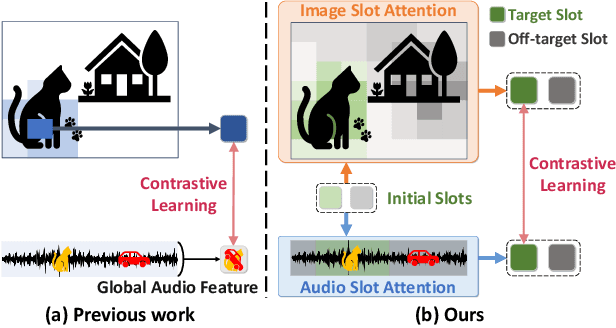
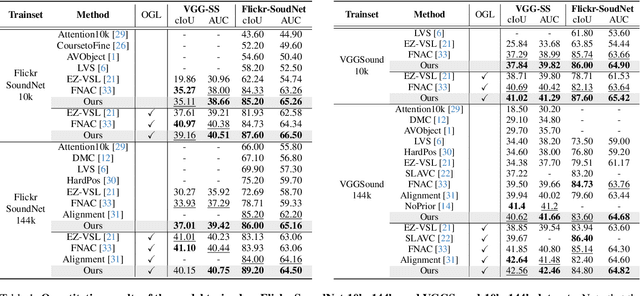
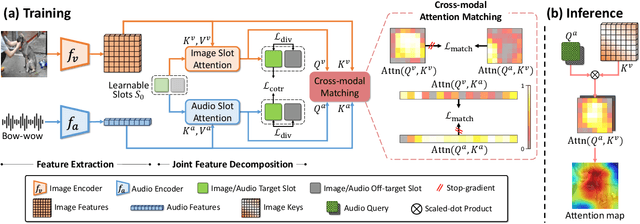
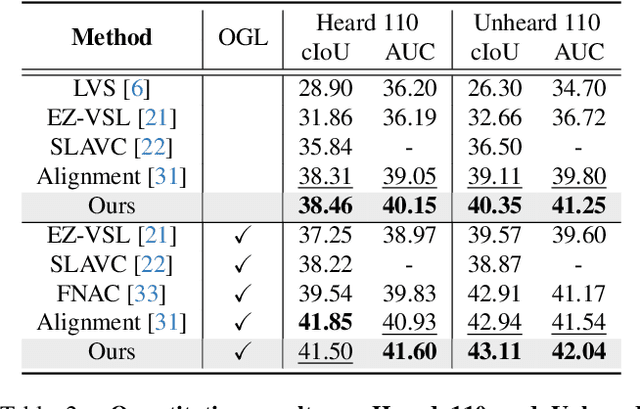
Abstract:Sound source localization (SSL) is the task of locating the source of sound within an image. Due to the lack of localization labels, the de facto standard in SSL has been to represent an image and audio as a single embedding vector each, and use them to learn SSL via contrastive learning. To this end, previous work samples one of local image features as the image embedding and aggregates all local audio features to obtain the audio embedding, which is far from optimal due to the presence of noise and background irrelevant to the actual target in the input. We present a novel SSL method that addresses this chronic issue by joint slot attention on image and audio. To be specific, two slots competitively attend image and audio features to decompose them into target and off-target representations, and only target representations of image and audio are used for contrastive learning. Also, we introduce cross-modal attention matching to further align local features of image and audio. Our method achieved the best in almost all settings on three public benchmarks for SSL, and substantially outperformed all the prior work in cross-modal retrieval.
Modality-Agnostic Style Transfer for Holistic Feature Imputation
Mar 03, 2025


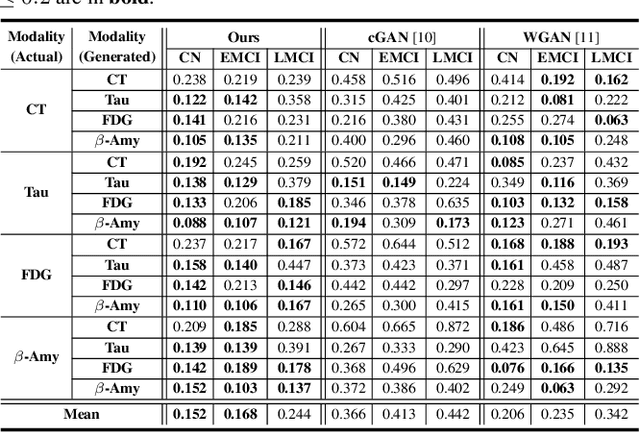
Abstract:Characterizing a preclinical stage of Alzheimer's Disease (AD) via single imaging is difficult as its early symptoms are quite subtle. Therefore, many neuroimaging studies are curated with various imaging modalities, e.g., MRI and PET, however, it is often challenging to acquire all of them from all subjects and missing data become inevitable. In this regards, in this paper, we propose a framework that generates unobserved imaging measures for specific subjects using their existing measures, thereby reducing the need for additional examinations. Our framework transfers modality-specific style while preserving AD-specific content. This is done by domain adversarial training that preserves modality-agnostic but AD-specific information, while a generative adversarial network adds an indistinguishable modality-specific style. Our proposed framework is evaluated on the Alzheimer's Disease Neuroimaging Initiative (ADNI) study and compared with other imputation methods in terms of generated data quality. Small average Cohen's $d$ $< 0.19$ between our generated measures and real ones suggests that the synthetic data are practically usable regardless of their modality type.
Learning Covariance-Based Multi-Scale Representation of Neuroimaging Measures for Alzheimer Classification
Mar 03, 2025Abstract:Stacking excessive layers in DNN results in highly underdetermined system when training samples are limited, which is very common in medical applications. In this regard, we present a framework capable of deriving an efficient high-dimensional space with reasonable increase in model size. This is done by utilizing a transform (i.e., convolution) that leverages scale-space theory with covariance structure. The overall model trains on this transform together with a downstream classifier (i.e., Fully Connected layer) to capture the optimal multi-scale representation of the original data which corresponds to task-specific components in a dual space. Experiments on neuroimaging measures from Alzheimer's Disease Neuroimaging Initiative (ADNI) study show that our model performs better and converges faster than conventional models even when the model size is significantly reduced. The trained model is made interpretable using gradient information over the multi-scale transform to delineate personalized AD-specific regions in the brain.
OCL: Ordinal Contrastive Learning for Imputating Features with Progressive Labels
Mar 03, 2025Abstract:Accurately discriminating progressive stages of Alzheimer's Disease (AD) is crucial for early diagnosis and prevention. It often involves multiple imaging modalities to understand the complex pathology of AD, however, acquiring a complete set of images is challenging due to high cost and burden for subjects. In the end, missing data become inevitable which lead to limited sample-size and decrease in precision in downstream analyses. To tackle this challenge, we introduce a holistic imaging feature imputation method that enables to leverage diverse imaging features while retaining all subjects. The proposed method comprises two networks: 1) An encoder to extract modality-independent embeddings and 2) A decoder to reconstruct the original measures conditioned on their imaging modalities. The encoder includes a novel {\em ordinal contrastive loss}, which aligns samples in the embedding space according to the progression of AD. We also maximize modality-wise coherence of embeddings within each subject, in conjunction with domain adversarial training algorithms, to further enhance alignment between different imaging modalities. The proposed method promotes our holistic imaging feature imputation across various modalities in the shared embedding space. In the experiments, we show that our networks deliver favorable results for statistical analysis and classification against imputation baselines with Alzheimer's Disease Neuroimaging Initiative (ADNI) study.
Machine Learning on Dynamic Functional Connectivity: Promise, Pitfalls, and Interpretations
Sep 17, 2024Abstract:An unprecedented amount of existing functional Magnetic Resonance Imaging (fMRI) data provides a new opportunity to understand the relationship between functional fluctuation and human cognition/behavior using a data-driven approach. To that end, tremendous efforts have been made in machine learning to predict cognitive states from evolving volumetric images of blood-oxygen-level-dependent (BOLD) signals. Due to the complex nature of brain function, however, the evaluation on learning performance and discoveries are not often consistent across current state-of-the-arts (SOTA). By capitalizing on large-scale existing neuroimaging data (34,887 data samples from six public databases), we seek to establish a well-founded empirical guideline for designing deep models for functional neuroimages by linking the methodology underpinning with knowledge from the neuroscience domain. Specifically, we put the spotlight on (1) What is the current SOTA performance in cognitive task recognition and disease diagnosis using fMRI? (2) What are the limitations of current deep models? and (3) What is the general guideline for selecting the suitable machine learning backbone for new neuroimaging applications? We have conducted a comprehensive evaluation and statistical analysis, in various settings, to answer the above outstanding questions.
Joint-Embedding Predictive Architecture for Self-Supervised Learning of Mask Classification Architecture
Jul 15, 2024



Abstract:In this work, we introduce Mask-JEPA, a self-supervised learning framework tailored for mask classification architectures (MCA), to overcome the traditional constraints associated with training segmentation models. Mask-JEPA combines a Joint Embedding Predictive Architecture with MCA to adeptly capture intricate semantics and precise object boundaries. Our approach addresses two critical challenges in self-supervised learning: 1) extracting comprehensive representations for universal image segmentation from a pixel decoder, and 2) effectively training the transformer decoder. The use of the transformer decoder as a predictor within the JEPA framework allows proficient training in universal image segmentation tasks. Through rigorous evaluations on datasets such as ADE20K, Cityscapes and COCO, Mask-JEPA demonstrates not only competitive results but also exceptional adaptability and robustness across various training scenarios. The architecture-agnostic nature of Mask-JEPA further underscores its versatility, allowing seamless adaptation to various mask classification family.
Decoupled Marked Temporal Point Process using Neural Ordinary Differential Equations
Jun 10, 2024Abstract:A Marked Temporal Point Process (MTPP) is a stochastic process whose realization is a set of event-time data. MTPP is often used to understand complex dynamics of asynchronous temporal events such as money transaction, social media, healthcare, etc. Recent studies have utilized deep neural networks to capture complex temporal dependencies of events and generate embedding that aptly represent the observed events. While most previous studies focus on the inter-event dependencies and their representations, how individual events influence the overall dynamics over time has been under-explored. In this regime, we propose a Decoupled MTPP framework that disentangles characterization of a stochastic process into a set of evolving influences from different events. Our approach employs Neural Ordinary Differential Equations (Neural ODEs) to learn flexible continuous dynamics of these influences while simultaneously addressing multiple inference problems, such as density estimation and survival rate computation. We emphasize the significance of disentangling the influences by comparing our framework with state-of-the-art methods on real-life datasets, and provide analysis on the model behavior for potential applications.
CNA-TTA: Clean and Noisy Region Aware Feature Learning within Clusters for Online-Offline Test-Time Adaptation
Jan 26, 2024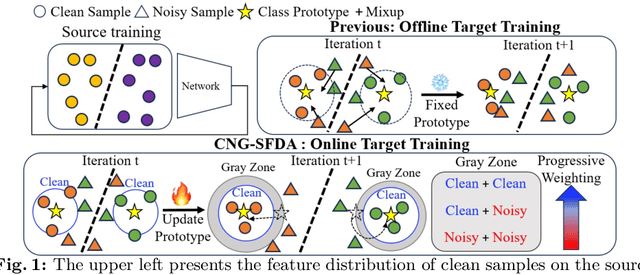

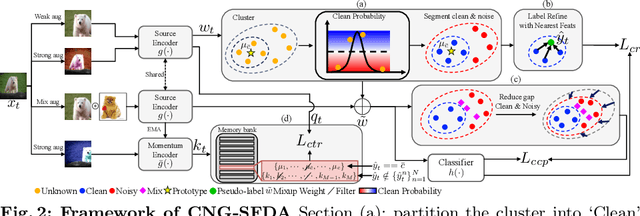
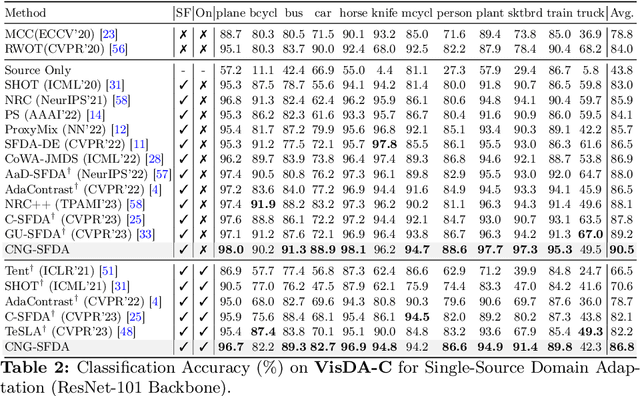
Abstract:A domain shift occurs when training (source) and test (target) data diverge in their distribution. Test-time adaptation (TTA) addresses the domain shift problem, aiming to adopt a trained model on the source domain to the target domain in a scenario where only a well-trained source model and unlabeled target data are available. In this scenario, handling false labels in the target domain is crucial because they negatively impact the model performance. To deal with this problem, we propose to utilize cluster structure (i.e., {`Clean'} and {`Noisy'} regions within each cluster) in the target domain formulated by the source model. Given an initial clustering of target samples, we first partition clusters into {`Clean'} and {`Noisy'} regions defined based on cluster prototype (i.e., centroid of each cluster). As these regions have totally different distributions of the true pseudo-labels, we adopt distinct training strategies for the clean and noisy regions: we selectively train the target with clean pseudo-labels in the clean region, whereas we introduce mixup inputs representing intermediate features between clean and noisy regions to increase the compactness of the cluster. We conducted extensive experiments on multiple datasets in online/offline TTA settings, whose results demonstrate that our method, {CNA-TTA}, achieves state-of-the-art for most cases.
Learning to Approximate Adaptive Kernel Convolution on Graphs
Jan 22, 2024
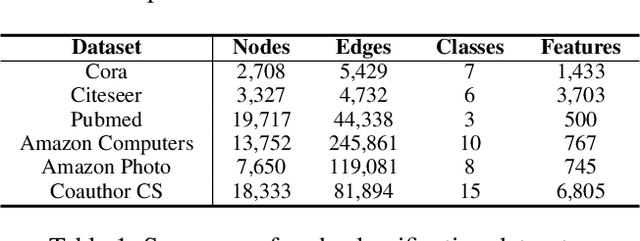
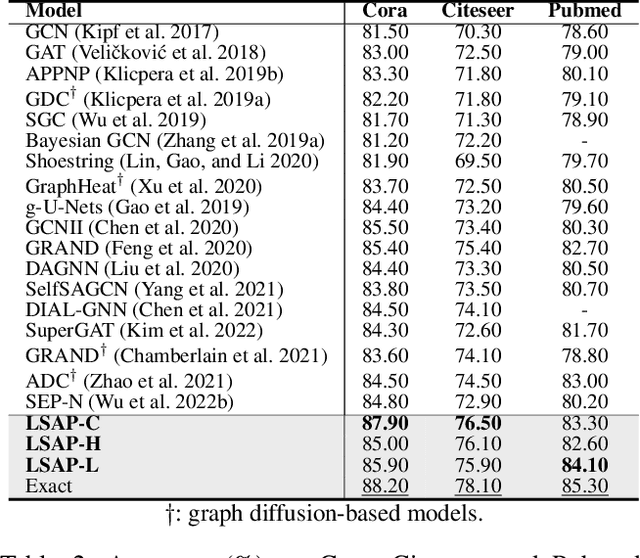
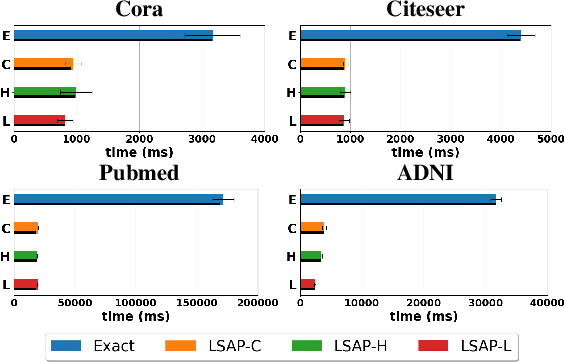
Abstract:Various Graph Neural Networks (GNNs) have been successful in analyzing data in non-Euclidean spaces, however, they have limitations such as oversmoothing, i.e., information becomes excessively averaged as the number of hidden layers increases. The issue stems from the intrinsic formulation of conventional graph convolution where the nodal features are aggregated from a direct neighborhood per layer across the entire nodes in the graph. As setting different number of hidden layers per node is infeasible, recent works leverage a diffusion kernel to redefine the graph structure and incorporate information from farther nodes. Unfortunately, such approaches suffer from heavy diagonalization of a graph Laplacian or learning a large transform matrix. In this regards, we propose a diffusion learning framework, where the range of feature aggregation is controlled by the scale of a diffusion kernel. For efficient computation, we derive closed-form derivatives of approximations of the graph convolution with respect to the scale, so that node-wise range can be adaptively learned. With a downstream classifier, the entire framework is made trainable in an end-to-end manner. Our model is tested on various standard datasets for node-wise classification for the state-of-the-art performance, and it is also validated on a real-world brain network data for graph classifications to demonstrate its practicality for Alzheimer classification.
 Add to Chrome
Add to Chrome Add to Firefox
Add to Firefox Add to Edge
Add to Edge